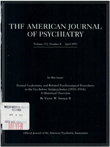Evidence that decreased function of lymphocyte beta adrenoreceptors reflects regulatory and adaptive processes in panic disorder with agoraphobia
Abstract
OBJECTIVE: This study was designed to clarify the nature of the reduced function of the peripheral beta adrenoceptor system observed in panic disorder with agoraphobia. The authors hypothesized that this phenomenon reflected a regulatory and adaptive process. METHODS: Lymphocyte beta adrenoreceptor density and affinity, basal lymphocyte cAMP level, and isoproterenol-stimulated cAMP generation were measured in 27 untreated outpatients with panic disorder with agoraphobia and 24 healthy comparison subjects. Lymphocyte beta receptor attributes were again assessed in patients after 4 weeks of double-blind treatment with adinazolam (slow-release form) or placebo. Panic frequency, agoraphobic symptoms, overall anxiety, and improvement with treatment were assessed with standard rating instruments. RESULTS: Multivariate statistics revealed significantly lower beta receptor density and isoproterenol- stimulated cAMP generation in patients than in comparison subjects. beta receptor density tended to normalize after adinazolam but not after placebo. Pretreatment beta receptor density was lower in treatment responders than nonresponders. Patients with mild agoraphobia had lower cAMP responsivity than patients with moderate or severe agoraphobia. CONCLUSIONS: Decreased function of lymphocyte beta receptors in panic disorder with agoraphobia is expressed as both decreased density and decreased cAMP responsivity. This pattern of changes, and the tendency for receptor density to normalize with treatment, is consistent with an active, regulatory process rather than a structural deficit in the beta receptor system. Preliminary clinical findings suggest that these changes may reflect adaptive processes associated with a favorable clinical course in panic disorder with agoraphobia.
Access content
To read the fulltext, please use one of the options below to sign in or purchase access.- Personal login
- Institutional Login
- Sign in via OpenAthens
- Register for access
-
Please login/register if you wish to pair your device and check access availability.
Not a subscriber?
PsychiatryOnline subscription options offer access to the DSM-5 library, books, journals, CME, and patient resources. This all-in-one virtual library provides psychiatrists and mental health professionals with key resources for diagnosis, treatment, research, and professional development.
Need more help? PsychiatryOnline Customer Service may be reached by emailing [email protected] or by calling 800-368-5777 (in the U.S.) or 703-907-7322 (outside the U.S.).



